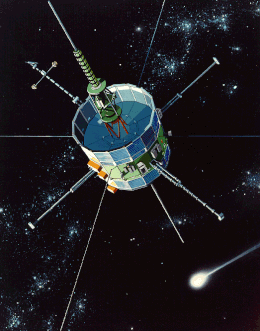International Cometary Explorer

Artist rendering of ICE
|
|||||||||||||||||||||||||||||
| Names |
International Sun-Earth Explorer-3 International Sun-Earth Explorer-C Explorer 59 |
||||||||||||||||||||||||||||
|---|---|---|---|---|---|---|---|---|---|---|---|---|---|---|---|---|---|---|---|---|---|---|---|---|---|---|---|---|---|
| Mission type |
Magnetospheric research ISEE-3: Earth/Moon L1 orbiter ICE: 21P/G-Z & Halley fly-by |
||||||||||||||||||||||||||||
| Operator | NASA | ||||||||||||||||||||||||||||
| COSPAR ID | 1978-079A | ||||||||||||||||||||||||||||
| SATCAT no. | 11004 | ||||||||||||||||||||||||||||
| Mission duration | Final: 18 years, 8 months and 23 days | ||||||||||||||||||||||||||||
| Spacecraft properties | |||||||||||||||||||||||||||||
| Manufacturer | Fairchild Industries | ||||||||||||||||||||||||||||
| Launch mass | 479 kg (1,056 lb) | ||||||||||||||||||||||||||||
| Dry mass | 390 kg (860 lb) | ||||||||||||||||||||||||||||
| Dimensions | 1.77 × 1.58 m (5.8 × 5.2 ft) | ||||||||||||||||||||||||||||
| Power | 173 W | ||||||||||||||||||||||||||||
| Start of mission | |||||||||||||||||||||||||||||
| Launch date | August 12, 1978, 15:12 UTC | ||||||||||||||||||||||||||||
| Rocket | Delta 2914 #144 | ||||||||||||||||||||||||||||
| Launch site | Cape Canaveral SLC-17B | ||||||||||||||||||||||||||||
| End of mission | |||||||||||||||||||||||||||||
| Disposal | Contact suspended | ||||||||||||||||||||||||||||
| Deactivated | May 5, 1997 | ||||||||||||||||||||||||||||
| Orbital parameters | |||||||||||||||||||||||||||||
| Reference system | Heliocentric | ||||||||||||||||||||||||||||
| Eccentricity | 0.05 | ||||||||||||||||||||||||||||
| Perihelion | 0.93 AU (139,000,000 km; 86,400,000 mi) |
||||||||||||||||||||||||||||
| Apohelion | 1.03 AU (154,000,000 km; 95,700,000 mi) |
||||||||||||||||||||||||||||
| Inclination | 0.1° | ||||||||||||||||||||||||||||
| Period | 355 days | ||||||||||||||||||||||||||||
| Epoch | March 28, 1986, 00:00 UTC | ||||||||||||||||||||||||||||
|
|||||||||||||||||||||||||||||
|
|
|||||||||||||||||||||||||||||
| Instruments | |
|---|---|
| Solar Wind Plasma Experiment | |
| Helium Vector Magnetometer | |
| Low Energy Cosmic Ray Experiment | |
| Medium Energy Cosmic Ray Experiment | |
| High Energy Cosmic Ray Experiment | |
| Plasma Wave Instrument | |
| Low Energy Proton Experiment | |
| Cosmic Ray Electrons and Nuclei | |
| X-Rays and Electrons Instrument | |
| Radio Mapping Experiment | |
| Plasma Composition Experiment | |
| Heavy Isotope Spectrometer Telescope | |
| Ground Based Solar studies Experiment |
The International Cometary Explorer (ICE) spacecraft (designed and launched as the International Sun-Earth Explorer-3 (ISEE-3) satellite), was launched August 12, 1978, into a heliocentric orbit. It was one of three spacecraft, along with the mother/daughter pair of ISEE-1 and ISEE-2, built for the International Sun-Earth Explorer (ISEE) program, a joint effort by NASA and ESRO/ESA to study the interaction between the Earth's magnetic field and the solar wind.
ISEE-3 was the first spacecraft to be placed in a halo orbit at the L1 Earth-Sun Lagrangian point. Renamed ICE, it became the first spacecraft to visit a comet, passing through the plasma tail of comet Giacobini-Zinner within about 7,800 km (4,800 mi) of the nucleus on September 11, 1985.
NASA suspended routine contact with ISEE-3 in 1997, and made brief status checks in 1999 and 2008.
On May 29, 2014, two-way communication with the spacecraft was reestablished by the ISEE-3 Reboot Project, an unofficial group with support from the Skycorp company. On July 2, 2014, they fired the thrusters for the first time since 1987. However, later firings of the thrusters failed, apparently due to a lack of nitrogen pressurant in the fuel tanks. The project team initiated an alternative plan to use the spacecraft to "collect scientific data and send it back to Earth," but on September 16, 2014, contact with the probe was lost.
ISEE-3 carries no cameras; instead, its instruments measure energetic particles, waves, plasmas, and fields.
ISEE-3 originally operated in a halo orbit about the L1 Sun-Earth Lagrangian point, 235 Earth radii above the surface (about 1.5 million km, or 924,000 miles). It was the first artificial object placed at a so-called "libration point", entering orbit there on November 20, 1978, proving that such a suspension between gravitational fields was possible. It rotates at 19.76 rpm about an axis perpendicular to the ecliptic, to keep it oriented for its experiments, to generate solar power and to communicate with Earth.
...
Wikipedia
